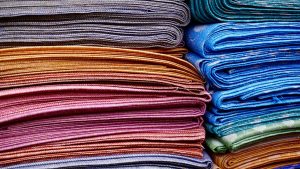COTTON FIBERS
In the case of cotton fiber products, the next technological process at the preparation stage is mercerization aimed at improving the stability, strength and sorption capacity of the fibers and making them shiny. It consists in processing in a sodium hydroxide solution. Means supporting the mercerization process are used.
Another process in the case of cellulose fibers is bleaching, which is to remove the natural color of the fibers, mainly due to impurities. The most common methods of bleaching are treatment in a solution of hydrogen peroxide, hypochlorite and sodium chlorite. The hypochlorite-peroxide method is also used.
WOOLEN FIBERS
In the case of wool fibers, the pre-treatment consists of: carbonization, washing and bleaching.
Carbonization – degradation of plant pollutants in a hot solution of sulfuric acid. Then their mechanical removal and neutralization.
Prewash is designed to remove substances deposited in previous operations. Washing is supposed to increase the wettability and absorbency of wool fibers, facilitating their further processing. The most common methods are water washing with the use of appropriate detergents or solvent washing.
The bleaching agents used are hydrogen peroxide. Bleaching with a reducing agent can additionally be carried out using hydrosulfite.
POLYESTER AND POLYAMIDE FIBERS
Articles made of artificial and synthetic fibers.
Prewash is designed to remove previously applied preparations and auxiliaries.
Thermal stabilization – hot air treatment to ensure shape stability.



